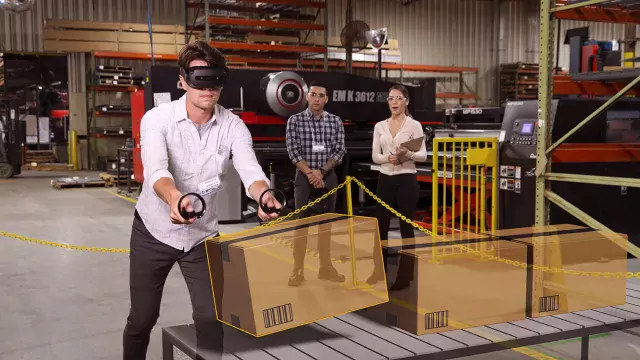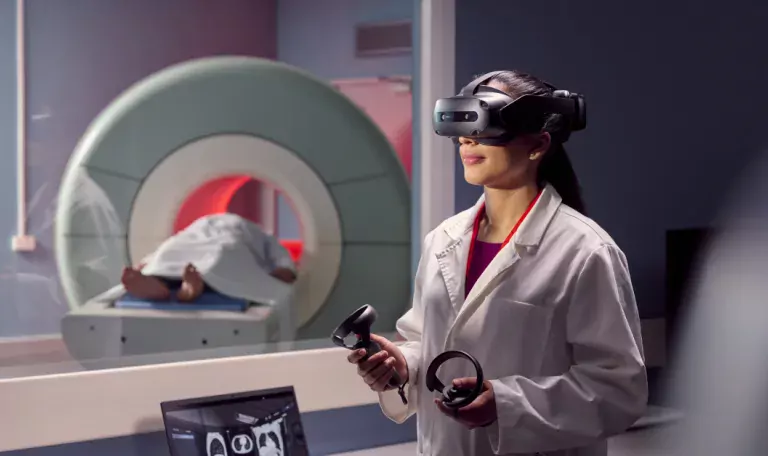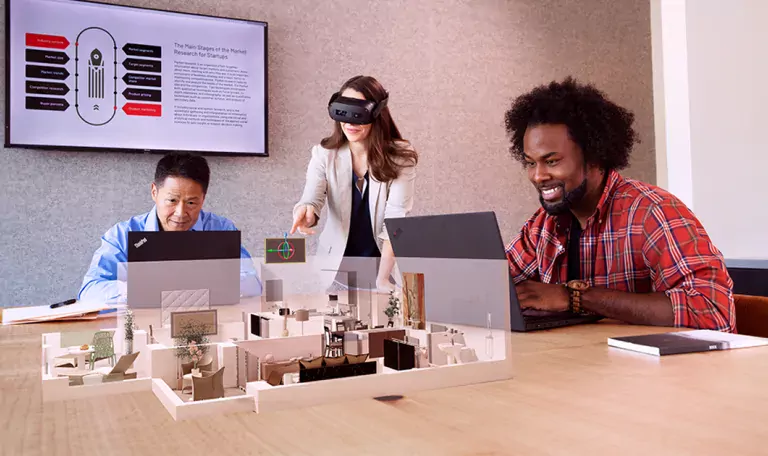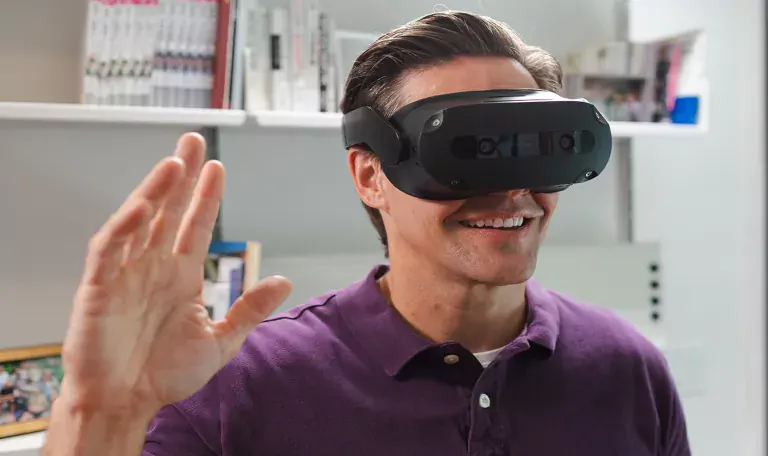The VR that works for training
Many companies devote considerable sums for employee skill development as they seek a competitive advantage in the marketplace. In the U.S. alone, training expenses exceeded $100 billion dollars in 2022.i However, to provide the best possible outcomes within organizations, Learning & Development (L&D) professionals must overcome the obstacles of expense and logistics headaches, retention of subject matter, limitations of lecture- and computer-based training, and difficulties replicating real-world environments.
Employees not absorbing the content is an important concern, especially with the rise of hybrid and remote work. Among other reasons, educators and corporate trainers point to videoconferencing’s flat, 2D environment to account for the drops in learning-based outcomes during the COVID pandemic, when everyone was remote.
Virtual reality is quickly distinguishing itself as the solution that combines the strengths of on-site and remote learning.
The market continues to grow
Overall, the viability of VR as a business tool has drawn significant investments from household names such as Microsoft, Lenovo, and Meta. There are a host of start-ups as well, primarily on the software side. One study appraised the VR market at $6.1 billion in 2020 and projected the growth to $20.9 billion by 2025.ii
For workplace training in particular, organizations in a wide range of fields and departments ̶ from healthcare to Human Resources ̶ are incorporating VR. The ease of use, cost savings, and especially the dramatically improved outcomes of immersive visual simulations have created a new paradigm.
The advantages of VR over traditional training methods
It’s faster: A recent Price Waterhouse Coopers study found that when training on soft skills such as customer service, leadership, or HR tasks, employees completed VR programs up to four times faster compared to classroom learning.iii
It’s more powerful: The immersive environment of virtual reality is flat-out cool. Attendees enjoy the sessions. There’s greater retention as there are no distractions, and participants are more ready to transfer their learning into the workplace. PWC found that employees were four times more focused than their e-learning peers and felt 275% more confident to apply the skills they learned after VR training.3 And the bigger you are, the better it gets. When compared to classroom learning, VR training was:
- 52% more effective at 3,000 learners
- 58% more effective at 6,000 learners
- 64% more cost effective at 10,000 learners3
It’s cost effective: VR greatly reduces the often-high expenses associated with development. Plus, personnel aren’t offline while in transit, and logistics becomes less of a concern as schedules don’t have to be juggled for disparate team members.
Areas of focus with VR training
L&D has long struggled with training for inaccessible and dangerous settings, as on an oil rig or construction equipment, or with hazardous chemicals. VR allows simulations in areas like these and others that can’t be replicated. Its immersive environment provides the feeling of hands-on training without being on the site, while ensuring the safety of participants.
Plus, with technology like Lenovo’s six degrees of freedom (6DoF), trainees can enter and walk around in a complex world, like a lab environment or the cabin of an industrial machine. This feeling of “being there” can’t be replicated online and provides a distinct training advantage with VR.
The result is a learning experience that translates readily into the real world: companies in high-risk industries experienced a 43% reduction in workplace injuries after implementing VR training.iv
VR is finding a home in healthcare. It solves the problem of depending on busy nurses and doctors to lead sessions or hiring actors to stage faux cases. It also removes the liabilities inherent when patient care is involved. Healthcare providers can now perform complex surgery simulations and immersive clinicals without risk. And with granular data collection, down to eye and body movements, performances can be tracked and evaluated as users hone their skills.
It's being applied to learners on all levels. At the Ohio State College of Medicine, students learn hands-on how to respond when a patient goes into cardiac arrest. Or, in a scenario-based environment, they become first responders in a mass casualty event. Through VR, they can identify who needs treatment first and other priorities in an emergency.v
On the other end of the experience scale, a neurosurgeon at the Cleveland Clinic can practice a complex operation using their patient’s real brain scans before doing the actual procedure. “Giving physicians real-life experience… will improve outcomes every time,” says Pieter VanIperen of PWV Consultants, a VR software creator.5
A global consulting firm is using VR to train and onboard new employees more quickly, reducing travel time and overhead. They found that after active experiences in the metaverse, employees are more ready to step into what they’ve learned, as opposed to a passive experience like reading. In addition, many new hires are from Generations Y and Z, who are comfortable with and even expect the adoption of emerging technologies. VR training strengthens the identification they feel with their employer.
The evolution of VR headsets
User satisfaction is increasing as the technology matures. For instance, long sessions of VR training could once lead to risks of user fatigue, primarily because early headsets were bulky and heavy. Now, models such as Lenovo’s ThinkReality VRX headset are compact, with an innovative smaller lens and long-life battery. They are comfortable, even after extended wear times, thanks to the slim, well-balanced design.
A popular feature is a forward-facing camera that enables pass-through video, which allows users to switch between their virtual and real worlds seamlessly without removing their headsets. Pass-through video even enables mixed reality (MR), where virtual elements can be overlaid on top of the real-world workspace.
It is durably constructed for commercial use and easily sanitized with a wipe, which is important as users often share the headsets within a company.
Take the smarter step into enterprise VR
Incorporating features that make VR training a reality, the ThinkReality VRX headset takes advantage of the latest technology from pancake lenses; hygienic, durable materials; and 6DoF technology. It was built with enterprise demands in mind. Click on the link for more information and to schedule a demo to see for yourself how Lenovo is enabling workplace training.
Click here to learn more.




